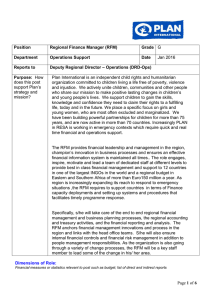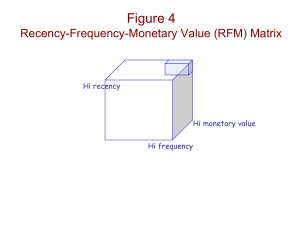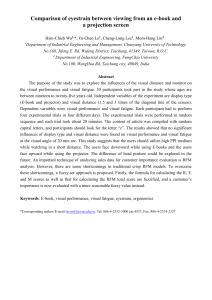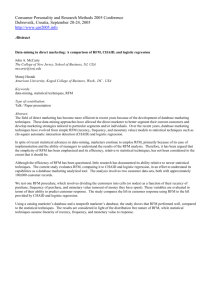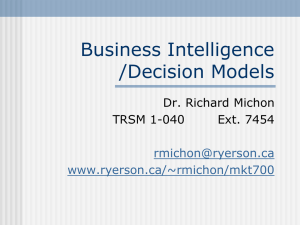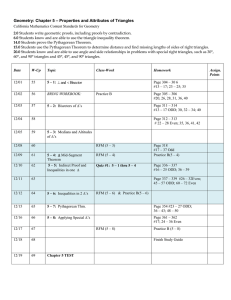Customer Segmentation based on Modified RFM Model in the Insurance Industry
advertisement
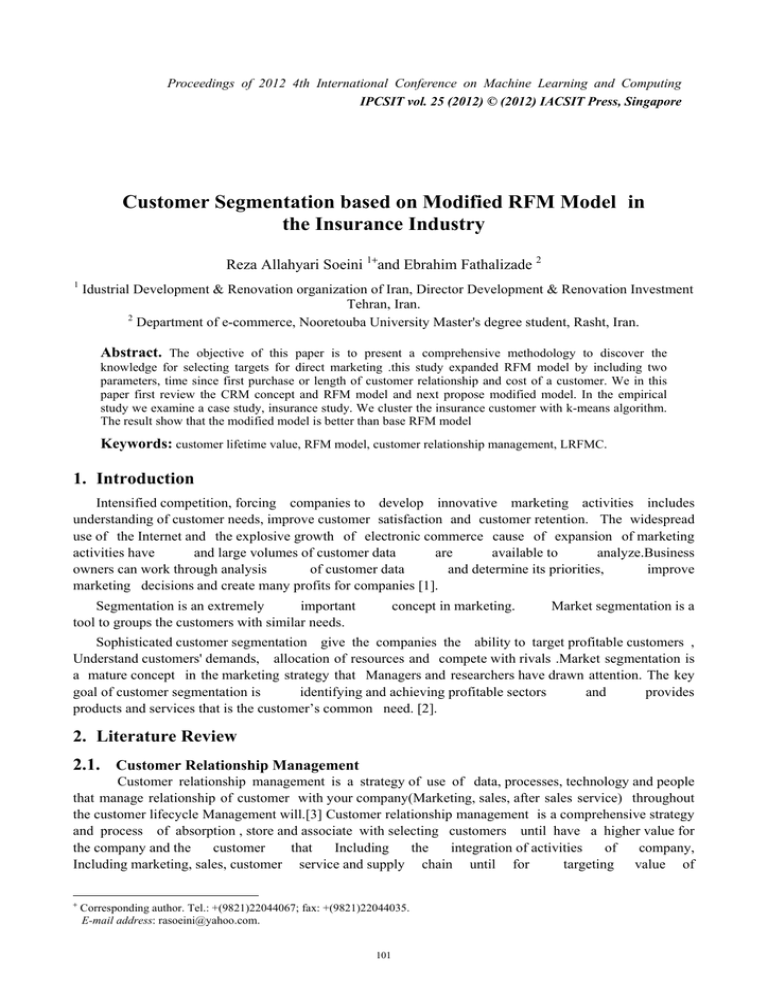
Proceedings of 2012 4th International Conference on Machine Learning and Computing IPCSIT vol. 25 (2012) © (2012) IACSIT Press, Singapore Customer Segmentation based on Modified RFM Model in the Insurance Industry Reza Allahyari Soeini 1+and Ebrahim Fathalizade 2 1 Idustrial Development & Renovation organization of Iran, Director Development & Renovation Investment Tehran, Iran. 2 Department of e-commerce, Nooretouba University Master's degree student, Rasht, Iran. Abstract. The objective of this paper is to present a comprehensive methodology to discover the knowledge for selecting targets for direct marketing .this study expanded RFM model by including two parameters, time since first purchase or length of customer relationship and cost of a customer. We in this paper first review the CRM concept and RFM model and next propose modified model. In the empirical study we examine a case study, insurance study. We cluster the insurance customer with k-means algorithm. The result show that the modified model is better than base RFM model Keywords: customer lifetime value, RFM model, customer relationship management, LRFMC. 1. Introduction Intensified competition, forcing companies to develop innovative marketing activities includes understanding of customer needs, improve customer satisfaction and customer retention. The widespread use of the Internet and the explosive growth of electronic commerce cause of expansion of marketing activities have and large volumes of customer data are available to analyze.Business owners can work through analysis of customer data and determine its priorities, improve marketing decisions and create many profits for companies [1]. Segmentation is an extremely important tool to groups the customers with similar needs. concept in marketing. Market segmentation is a Sophisticated customer segmentation give the companies the ability to target profitable customers , Understand customers' demands, allocation of resources and compete with rivals .Market segmentation is a mature concept in the marketing strategy that Managers and researchers have drawn attention. The key goal of customer segmentation is identifying and achieving profitable sectors and provides products and services that is the customer’s common need. [2]. 2. Literature Review 2.1. Customer Relationship Management Customer relationship management is a strategy of use of data, processes, technology and people that manage relationship of customer with your company(Marketing, sales, after sales service) throughout the customer lifecycle Management will.[3] Customer relationship management is a comprehensive strategy and process of absorption , store and associate with selecting customers until have a higher value for the company and the customer that Including the integration of activities of company, Including marketing, sales, customer service and supply chain until for targeting value of + Corresponding author. Tel.: +(9821)22044067; fax: +(9821)22044035. E-mail address: rasoeini@yahoo.com. 101 customers gain greater efficiency and effectiveness[4]. Customer relationship management help to organizations for better distinguish , more efficient allocation of resources to group of customers that have the highest profitability .this work due to Customer relationship management cycle will be achieved .Detailed knowledge should be made to gain a deeper understanding of customer behavior , His attributes and needs. Customer relationship management includes four steps that are: Customer identification, customer attraction, and customer retention and customer development [5]. 2.2. Customer Lifetime Value Recently , increased emphasis for CRM has been placed on developing a measurement to understand the value that customer created and to give managers a better idea of how their CRM policies and program are working [6] one of good candidates to develop this measurement is Customer Lifetime Value(CLV ) analysis which is the present value of all future profits generated from a customer [7, 8] Customer lifetime value has been studied under the many name such LTV (Life Time Value) , CLV( Customer Lifetime Value), CE (Customer Equity) and Customer Profitability. The previous researches define CLV as the sum of the revenues gained from company’s customers over the lifetime of transaction after the deduction of the total cost of attracting, selling and servicing customer.[9,10,11]. Customer lifetime value is gaining increaseing importance as a marketing metric in both academia and practice. Customer lifetime value Total revenue gained from customers of a company During the time of the transaction and their relationship Minus Total costs associated with recruiting, sales, customer service and also Calculate the present value of money Spending[12]From the perspective of customer relationship management, CLV Present value of future cash flows that is obtained from customer relationship[13]. 2.3. Model of CLV Calculation The basic model for determine customer lifetime value is shown in EQ1 [9]: (1) CLV= Where i is the period of cash flow from customer transaction , Ri the revenue from the customer in period i, Ci the total cost of generating the revenue Ri in period i, and n is total number of periods of projected life of customer under consideration 2.4. RFM Model The RFM model is the most frequently adopted segmentation technique that comprises three measures (regency, frequency and monetary). RFM model is a behavior-based model used to analyze the behavior of a customer and then make prediction based on the behavior in the database [14] moreover regency mean the length of a time period since the last purchase, while frequency mean the number of purchase within a specified time period ans monetary means the amount of money spent in this specified time period [15] RFM model measures when customer buy , how often they buy and how much they buy. While previous purchases of customer can effectively predict their future purchase behavior, firms can identify which customer is Competent to be contacted based on his or her past purchase behavior via RFM model. RFM model widely applied in database marketing and is a common tool to develop marketing strategies [16 ] 3. A New Nodel for Determining Customer Lifetime Value (LRFMC) In general, to determine customer lifetime value model based on basic model Total income earned from a customer minus the cost for the business to earn income is calculated .RFM model is one of the most powerful models. And also the simplest model is to determine customer lifetime value. That has been used extensively. Researchers to optimize RFM model, tried to make changes in the model. For example [21] for determine customer lifetime value with RFM model and another variable added to RFM model that called L. This variable mean duration of customer relationship, so their model is composed of four dimension. [22] presented a model that In addition to the three variables of RFM model have two extra variables: T, C that About communicating with customers and potential customers churn and their model called RFMTC 102 MODEL . The review of existing models to determining customer lifetime value based on RFM model, note that cost of the customer cost calculations do not consider themselves one of the important variables in determining customer lifetime value Is the variable cost that In the basic model of customer lifetime value determine customer lifetime value. We expand RFM model with two variables, L, C. The variable L is the length of time the customer relationship and C variable related to customer costs and our model is called LRFMC. 4. Case Study: Insurance Industry To illustrate the model on the insurance industry LRFMC, we collected data of 120 customers through questionnaires to run our model. We define the variables in the insurance industry. Each record of customer information Includes variable :L (Duration of customer relationship), R (last time that customer purchase insurance(Policy) by year), F(the number of insurance policies that customer purchase) , M( amount of payment for insurance policy ) and C(average customer damage in his relationship). We with SPSS software and k-means algorithm segment the customer to groups. The optimal size of k with attention to errors of different segmentation is 7. So we segment customer to 7 groups that shown in figure 1. In the Table 1 we describe attribute of each group. Fig. 1: K-means clustering Table. 1: Description of clusters Number of cluster attributes 1 This cluster is my best cluster. Customer that have high score in all variable. 7 Customer of this cluster are my old customer and don't have high cost and buy recently but they high monetary and frequency. 6 3 This cluster is similar to cluster .but this cluster have high cost and lower relationship length Customer in this cluster are Newest and hight score of cost . but they have low score of RFM variable. 4 This cluster is similar to cluster 7 .but this cluster is lower score in cost. 5 Customer of this cluster have high score in all variable but they dont buy recently. 2 This customer are high score in frequency and monetary and are my old customer but they have low score in cost and recently. 103 5. Analyse of Model Using association rules, we compare the new model with RFM model and the results show that the new model has a better function. Result show in Table 2: Table. 2: Association rules result Consequent Support % Confidence % Lift RFMCL 13 92.308 6.152 RFM 11.667 91.143 5.562 6. Conclusion In this study we examine the RFM model and we tried to make the model more efficient .variables time of relationship and associated costs added to the model. We used association rules to compare two models. The result was that the new model works better than the RFM. 7. References [1] Liu, D. R., & Shih, Y.-Y. Integrating AHP and data mining for product recommendation based on customer lifetime value. Information & Management. 2005 , 387–400. [2] Blocker, C. P., & Flint, D. J. Customer segments as moving targets: Integrating customer value dynamism into segment instability logic. Industrial Marketing Management. 2007, 36 , 810–822. [3] Kincaid , J,W. Customer relationship management : Getting it right. Upper saddle river. N.J.: Prentice HALL PTR, 2003. [4] Parvatiyar. A., & Sheth, J . N. Customer relationship management : Emerging practice . process , and discipline. Journal of Economic & Social Research. 2001, 3, 1-34. [5] Ling .R., & Yen . D.C . Customer relationship management : An analysis framework and Implementation strategies . Journal of Computer Information System. 2001, 41, 82-97. [6] Winer , R.S, “A framework for customer relationship management , ” California Management Review. 2001 , 43, 89-105. [7] Gupta , Sunil and Donald R. Lehmann, “Customer as asset, ” Journal of Interactive Marketing . 2003, 17(1), 9-24. [8] Haenlein , Michael , Andreas M. Kaplan , and Anemone J. Beeser, “A Model to Determine Customer Lifetime Value in Retail Banking Context , ” European Management Journal. 2007 , 25(3), 221-34. [9] Jain D, Singh SS . “Customer Lifetime Value Research in Marketing : A Review and Future Directions” . J. Interactive Mark. 2002. 16(2):34-46. [10] Dwyer , F,R. Customer lifetime valuation to support marketing decision making . Journal of Interactive Marketing. 1997 , 11(4), 6-13 [11] [11] Hoekstra, J. C. , & Hurzingh, E.K.R.E . The lifetime value concept in customer-base marketing , Journal of Market Focused Management .1999, 3(3-4), 257-274. [12] [12] Hwang, Hyunseok , Taesoo Jung , and Euigo Suh , “ An LTV model and customer segmentation based on customer value : a case study on the wireless telecommunication industry , ” Expert Systems with Applications. 2004 , 26, 181-188. [13] Pfeifer , Phillip E , Mark E Haskins , and Robert M Conroy, “Customer Lifetime Value , Customer Profitability , and the Treatment of Acquisition Spending, ” Journal of Managerial Issue. 2005 , 17,11-25. [14] Hughes AM. Boosting reponse with RFM. Mark . Tools .1996, 5:4-10. [15] Wang CH , Apply robust segmentation to the service industry usint kernel induced fuzzy clustering techniques. Expert Systems Application. 2010, 37: 8395-8400. [16] Wei Jo-Ting , Lin Shih-Yen and Wu Hsin-Hung , A review of the application of RFM model . African Journal of Business Management Vol. 4(19) 2010, Pp. 4199-4206. 104

